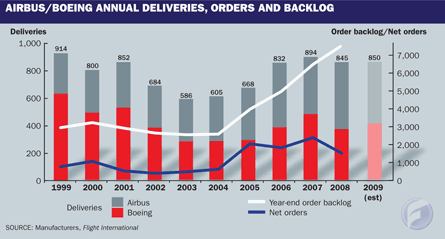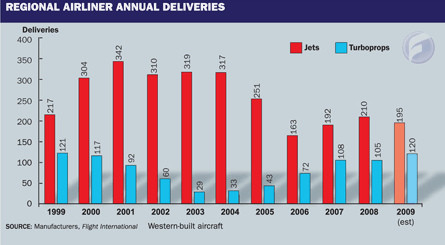After sales of more than 2,700 airframes in 2007 smashed all records, Airbus and Boeing's orders in 2008 were predicted to tumble - and that they did, falling over 40% to around 1,600 orders.
Forecasting orders in 2009 is far more uncertain, given the world's financial meltdown in the latter half of last year. But as a guide, it is worth recalling that in the industry's last slowdown after 9/11, combined net orders for Airbus and Boeing fell to as low as 400 to 500 units a year in 2002 and 2003.
"We don't need orders in 2009, we need fewer deferrals," says Teal Group's vice-president analysis Richard Aboulafia. "If we start seeing order activity in 2009, we can ignore it, because it will be very long term, or it will be at the expense of existing orders."
Aboulafia says that "backlog preservation" is crucial because there are no safe havens: "All the hot growth markets - India, China, Russia - look weak and risk overcapacity. The Middle East, which has been the biggest regional source of orders for the last two years, has suddenly been hit by serious equities and housing market downturns. Even orders from financial blue chips like ILFC and GECAS are uncertain."
 |
|---|
The impact of the credit crisis on output is equally difficult to predict, as the combination of tight financing and a general slump in demand will force some airlines to defer deliveries, or in some cases cease trading. Last year's combined output of around 850 aircraft was down slightly on 2007 after the Boeing machinists' strike affected Seattle's fourth quarter shipments, resulting in Boeing's full year total missing the target of 490 deliveries by a significant margin. At best, 2009's output will be flat and there could be falls of up to 20%, which would see deliveries dip below 700 to their level of three years ago.
BOEING FIRST FLIGHTS
The most hotly anticipated events of 2009 will - or should - be occurring in Seattle, with Boeing set to fly two new airliners. One of these, of course, is the 787, which had originally been due to fly in 2007 but has suffered a series of setbacks that have pushed back the first flight schedule into the second quarter of 2009.
The other new Boeing expected to take to the air in 2009 is the 747-8 - initially in freighter form. Again this programme has been delayed (by three to six months), with first flight now due in the third quarter, while deliveries to launch customer Cargolux have slipped into next year 2010. It is a fitting year for the latest 747 iteration to debut, given that 2009 marks the 40th anniversary of the original "Jumbo Jet's" maiden flight.
But achieving these first flights are only part of Boeing's challenge for these programmes in 2009. The airframer must resolve the production and supply problems that have dogged the Dreamliner for the past two years, and - despite the poor market conditions - find a second airline to join lonely launch customer Lufthansa for the 747-8 passenger model.
Airbus's challenges this year are probably no less daunting. Getting the A380 production ramp-up fully into its stride will be a major achievement - Airbus has promised to deliver 21 of the giants in 2009 - twice the number shipped in 2008.
AIRBUS ADVANCES
The European airframer will also start to move the A350 XWB from design to production and begin output of initial components. The definition freeze review was passed at the end of 2008, and work on the detail design of the parts will now begin in earnest.
Airbus will also be looking to mitigate the 2.2t weight growth that emerged in 2008, and ensure that it suffers no further increases.
The cargo sector should get a shot in the arm in 2009, with two all-new widebody load-lifters making their debuts. First will be Boeing's long awaited all-cargo 777 variant, deliveries of which are due to begin to Air France early in 2009. Meanwhile, Airbus is to begin flight-testing of its new A330-200F towards the end of the year with deliveries due to start to launch customer Flyington Freighters in spring next year.
One area of product development that will be high on to-do lists at Airbus and Boeing in 2009 will be their strategies in the single-aisle sector. Airbus has just finished a hands-on test of Pratt & Whitney's GTF geared turbofan, so should have the necessary data to decide if the engine should be adopted for an A320 mid-life update - or indeed any all-new design it is working on. Similarly, Boeing will need to keep abreast of developments in the sector to ensure it retains its strong presence in the market where it has delivered 5,800 737s - and another 2,800-plus 727s and 757s - over the past 40 years.
 |
|---|
The GTF already has two firm applications -the Bombardier CSeries and Mitsubishi MRJ regional jet - but questions remain about both new airframe programmes as the year begins. Bombardier is yet to firm up July's launch commitment from Lufthansa and nor has it secured additional customers, so the programme must move on to a firmer footing in 2009. Similarly, Mitsubishi will be eager to add to its customer list, which to date comprises a rather lonely "home" order from All Nippon Airways. Both aircraft are due to debut in 2013.
A less challenging task for Bombardier will be to complete the flight-test programme of the latest CRJ variant, the CRJ1000, ahead of service entry early in 2010. It is also facing the end of its Q Series "Classic" production this year as it winds up production of the Q200/Q300 models and concentrates purely on the Q400. A decision on the launch of the 90- to 100-seat Q400X stretch might be revisited in 2009.
At regional rival ATR, the pressure is mounting to secure a launch customer for the updated -600 family. Announced over a year ago, the airframer has begun ground testing work on the new model, but a customer has so far eluded it.
SUKHOI CERTIFICATION
This year should see a new large regional jet make its debut - if Sukhoi can complete the flight-test and certification programme of its 95-seat Superjet 100. A second flight development aircraft joined the programme at the end of 2008, so the test effort should now gather momentum towards the late 2009 certification target.
Another regional jet due to work through its flight-test programme in 2009 is China's ARJ21 twinjet, which took to the air in November. Realistically, this home-grown airliner - powered by GE CF34 engines - is unlikely to conclude flight-testing before mid-2010 at the earliest.
Finally, Russia's efforts to rebuild its once-proud airliner manufacturing sector must make progress in 2009 if the dream of producing a worthy next generation single-aisle airliner, the MS-21, is to be a reality. Some important decisions must be made this year if the programme is to move on to a firm footing, including a finalising of the design definition and the securing of partners - both international and domestic - to supply key system packages such as the powerplant.
Source: Flight International























